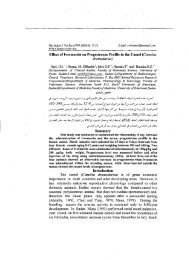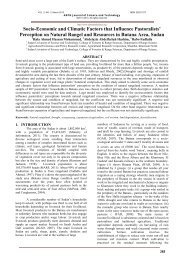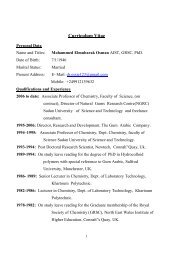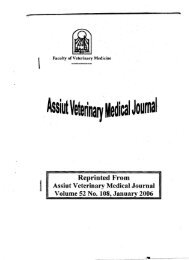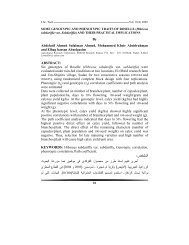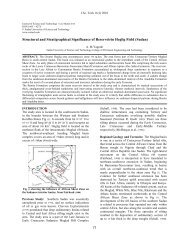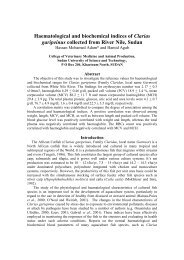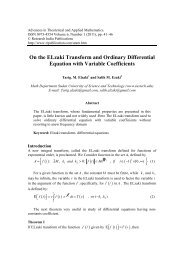toxicity of argemone mexicana seed, seed oil - Sudan University of ...
toxicity of argemone mexicana seed, seed oil - Sudan University of ...
toxicity of argemone mexicana seed, seed oil - Sudan University of ...
Create successful ePaper yourself
Turn your PDF publications into a flip-book with our unique Google optimized e-Paper software.
TOXICITY OF ARGEMONE MEXICANA SEED, SEED OIL AND THEIR EXTRACTS ON<br />
ALBINO RATS<br />
By<br />
A. A. El gamal 1 2 1<br />
, O. S. A. Mohamed and S. A. Khalid<br />
1- Department <strong>of</strong> Pharmacognosy, Faculty <strong>of</strong> Pharmacy, <strong>University</strong> <strong>of</strong> Khartoum, P. O. Box 1996, Khartoum, <strong>Sudan</strong>, 2-<br />
College <strong>of</strong> Veterinary Medicine and Animal Production, <strong>Sudan</strong> <strong>University</strong> <strong>of</strong> Science and Technology, P. O. Box 204, Khartoum<br />
<strong>Sudan</strong>.<br />
KEY WORDS: Toxicity, Rats, extract, Argemone <strong>mexicana</strong>, clinicopathology.<br />
ABSTRACT<br />
Albino rats received A. <strong>mexicana</strong> <strong>seed</strong>, <strong>seed</strong> <strong>oil</strong> and ethanolic <strong>seed</strong> extracts in<br />
different dosages and routes <strong>of</strong> administration suffered hyperae-sthesia, inappetence,<br />
intermittent diarrhea, emaciation and decrease in body weight. Hepatorenal lesions<br />
accompanied with increase in serum GOT activity and urea concentration were the<br />
pathological findings in rats.<br />
INTRODUCTION<br />
Argemone <strong>mexicana</strong> L. a member <strong>of</strong> the family Papaveraceae is commonly<br />
found in <strong>Sudan</strong>.Bui and Muraveva (1973), and (Muraveva and Bui, 1974) studied A.<br />
<strong>mexicana</strong> <strong>of</strong> <strong>Sudan</strong>ese origin and reported the presence <strong>of</strong> alkaloids protopine,<br />
allocryptopine sanguinarine and chelerthrine and Khalid, (1985), found no trace <strong>of</strong><br />
morphine or codeine. (Oliver-Bever, 1986) reported that protopine stimulates the<br />
heart, blood pressure and respiration, as well as the striated and smooth muscles and<br />
allocryptopine slows down the heart and prolongs systole in rats, frogs, cats and<br />
rabbits. Sanguinarine inhibits neutral protease activity (Sakamoto, 1986) and prolongs<br />
the ventricular refractory period (Whittle et al., 1980). The potential role <strong>of</strong><br />
sanguinarine found in Argemone <strong>mexicana</strong> L. <strong>seed</strong> <strong>oil</strong>, as aetiology <strong>of</strong> epidemic<br />
dropsy glaucoma was suggested by (Sarker, 1948). Forensic scientists claim that<br />
numerous fatalities have occurred in <strong>Sudan</strong> due to addition <strong>of</strong> A. <strong>mexicana</strong> L. <strong>seed</strong>s to<br />
native alcoholic drinks (Aragi or Merrisa) probably arising from increase the narcotic<br />
potency. Therefore, information on <strong>toxicity</strong> is needed by law enforcement bodies. An<br />
experiment with rats was conducted to elucidate the clinicopathological effect <strong>of</strong> A.<br />
<strong>mexicana</strong> <strong>seed</strong> and <strong>seed</strong> extracts.<br />
MATERIALS AND METHODS<br />
Plant Material: A. <strong>mexicana</strong> <strong>seed</strong>s were collected from Hillet Kuku, Khartoum North,<br />
and ground with a mortar and pestle and then mixed in the diet.<br />
Animals: One hundred and twenty albino rats <strong>of</strong> both sexes, 45days <strong>of</strong> age and <strong>of</strong><br />
200gm average body weight were used. The rats were clinically healthy and housed<br />
within the premises <strong>of</strong> the Faculty <strong>of</strong> Pharmacy, <strong>University</strong> <strong>of</strong> Khartoum, and fed on<br />
rat diet (flour 75.3%, meat 15%, edible <strong>oil</strong> 7.5%, sodium chloride 1.5% and vitamins +<br />
amino acids 0.7%) and water provided ad. Libitum.<br />
Administration <strong>of</strong> Plant-Seed, Seed Oil and Extract: 120albino rats <strong>of</strong> both sexes, 45days <strong>of</strong><br />
age and 200gm average body weight were used. The rats were clinically healthy and<br />
housed within the premises <strong>of</strong> the Faculty <strong>of</strong> Pharmacy, <strong>University</strong> <strong>of</strong> Khartoum, and<br />
fed on rat diet consisted <strong>of</strong> (flour 75.3, meat 15, edible <strong>oil</strong> 7.5, sodium chloride 1.5<br />
and vitamins + amino acid 0.7%). The rats were divided randomly into 6 groups <strong>of</strong> 20<br />
each. Group1 rats were fed on ration containing 10% ground <strong>seed</strong>s while group 2 rats<br />
were fed on ration containing 10% <strong>seed</strong> <strong>oil</strong> (n-hexane extract). 50mg/kg <strong>of</strong> direct
ethanolic <strong>seed</strong> extract was dissolved in water and then administered intraperitoneally<br />
(i/p) to each rat in group 70% Ethanolic extract (obtained from the <strong>seed</strong>s remaining<br />
after extraction with n-hexane) at 250 and 500mg/kg were dissolved in drinking water<br />
<strong>of</strong> group 4 and 5 respectively. Group 6 rats were the undosed controls. Body weight<br />
<strong>of</strong> each rat was recorded weekly. Doses continued daily until the rats died or were<br />
slaughtered. Survivors groups 1, 2, 3, 4, 5 and 6 were slaughtered at days 31, 7, 25,<br />
22, 12 and 31 respectively.<br />
Serobiochemical Methods: Blood samples were collected immediately after slaughter by<br />
severing the cervical blood vessels were allowed to clot, centrifuged at 3000rpm and<br />
o<br />
the separated sera were stored at − 20 C until analyzed, for the activities <strong>of</strong> glutamate<br />
oxaloacetate transaminase (GOT), glutamate pyruvate transaminase (GPT) and alkaline<br />
phosphatase (ALP), and for the concentrations <strong>of</strong> uric acid, urea and total cholesterol<br />
by commercial kits (Cromatest Laboratories Knickerbocker, S.A.E. Barcelona, Spain).<br />
Serum total protein concentration was measured by a refractometer (No. 43098, Atago,<br />
Japan).<br />
Pathological Methods: Necropsy was made immediately after death or slaughter to identify<br />
gross lesions and specimens <strong>of</strong> heart, lungs, stomach, liver, kidneys, intestines, spleen,<br />
muscles, spinal cord and sciatic nerve were fixed in 10% neutral buffered formalin and<br />
processed for histopathology and stained with haematoxylin and eosin (H&E).<br />
Statistical Methods: Statistical Package for Social Science (SPSS) was used for the analysis<br />
<strong>of</strong> the data. Duncan’s multiple range test in the one-way ANOVA was used.<br />
RESULTS<br />
Clinical Findings: In rats <strong>of</strong> groups 1, 2, 3, 4 and 5 hyperaesthesia, inappetence,<br />
intermittent diarrhea, emaciation, decrease in body weight, erection <strong>of</strong> hair and<br />
weakness <strong>of</strong> the fore and hind limbs ended with complete paralysis are the prominent<br />
manifestations. These signs appear on days 4, 3, 12, 6 and 5 and are more severe in<br />
rats <strong>of</strong> groups 2, 5, 4, 3 and 1, respectively. Significant decrease (P < 0.05) in mean<br />
body weight/rat is observed in groups 1 (197.5–171.0), 2 (196.5-177.2), 3 (206.5–<br />
179), 4 (237–179) and 5 (216-190) gm, at the end <strong>of</strong> the experiment. The controls<br />
(group 6) showed an increase in mean body weight/rat from 171-197.5gm.<br />
Post-mortem Findings: The heart, liver, kidneys and intestine <strong>of</strong> rats in groups (1–5)<br />
showed slight to moderate congestion and/or haemorrhage. Catarrhal enteritis and<br />
fatty change and necrosis are seen in the liver (Fig. 1) and kidneys <strong>of</strong> the test rats.<br />
Severe inflammation is observed in the abdominal muscles and subcutaneous tissues<br />
at the site <strong>of</strong> injection (Fig. 2), in rats <strong>of</strong> (group 3). There are no lesions in the controlundosed<br />
rats (group 6).<br />
Histopathological Findings: Slight centrilobuar hepatocellular necrosis or fatty vaculation<br />
is detected in the liver <strong>of</strong> rats in groups (1 and 3). The hepatic necrosis or fatty<br />
vaculation extended to the midzone in groups (2, 4, and 5). Congestion <strong>of</strong> the<br />
sinusoids and accumulation <strong>of</strong> lymphocytes are also seen in the liver <strong>of</strong> treated<br />
groups.<br />
Some rats <strong>of</strong> groups (2, 3 and 5) show degeneration and necrosis <strong>of</strong> the renal<br />
glomeruli and cortical tubular cells. These tubules contain desquamated cells or<br />
acidophilic homogeneous material. Some rats in groups (2 and 5) show dilation <strong>of</strong> renal<br />
convoluted tubules. Scattered haemorrhagic foci are seen in the renal interstitial tissue<br />
specially in rats <strong>of</strong> groups (2 and 3). Lymphocytic aggregates are seen in the cortex <strong>of</strong> rats<br />
in (group 4).<br />
Haemosiderin deposits are seen in the red pulp <strong>of</strong> the spleen <strong>of</strong> dosed rats<br />
specially in groups (2, 3 and 5). Severe lymphocytic infiltration is observed in the
gastrointestinal mucosae and submucosae and the lumen <strong>of</strong> the intestine contained<br />
desquamated epithelial cells groups (1, 2, 4, and 5).<br />
There are slight emphysema, congestion, oedema and peribronchiolar<br />
lymphocytic infiltration in the treated rats specially in groups (2 and 5). Smalls cattered<br />
foci <strong>of</strong> haemorrhage are seen between the cardiac muscle fibres <strong>of</strong> rats in groups (2, 3 and<br />
5). Severe myositis with lymphocytic infiltration, necrosis or oedema <strong>of</strong> muscle bundles<br />
is seen in (group 3) at site <strong>of</strong> administration. None <strong>of</strong> the dosed rats showed changes in<br />
peripheral nerves or the spinal cord.<br />
Serum Chemistry: The results <strong>of</strong> serum analysis in rats are summarized in (Table 1). The 6<br />
groups gave significantly different mean values for each <strong>of</strong> measured parameters. The<br />
significance was determined at the level <strong>of</strong> P < 0.05, and was also calculated within the<br />
groups. Activities <strong>of</strong> GOT in groups 1, 2, 3 and 5 rats were significantly higher than the<br />
rest, group 4 was intermediate. The control group 6 showed the least GOT mean value.<br />
However, groups 2, 3, 4 and 5 were not different. The overall serum GOT activity gave<br />
probability at (P < 0.0001).<br />
Fig. (1): Fatty change in liver <strong>of</strong> dosed rats
Fig. (2): Severe inflammation at the abdominal muscles and subcutaneous tissue at the site <strong>of</strong> injection in<br />
rats <strong>of</strong> group 3<br />
Groups 2, 3, 4 and 5 had significantly higher GPT mean values, whereas the control group<br />
6 rats showed the least mean value. This least value was not different from that exhibited<br />
by group 1 rats. The activity <strong>of</strong> serum GPT gave a probability at (P < 0.02).<br />
The significant changes (P < 0.05) were seen in mean values <strong>of</strong> serum ALP<br />
activity when compared to control rats group 6 but this was within normal levels.<br />
The highest serum total protein mean value was shown by group 2 rats. Groups 1, 5 and 6<br />
gave significantly second higher total protein mean value. The control and group 4 were<br />
not significantly different, while groups 3 and 4 gave the least total protein contents. The<br />
probability within the group was found to be at (P < 0.0001).<br />
Group 1 rats gave the highest serum cholesterol level. Groups 2 and 6 showed<br />
intermediate comparable results, while groups 3, 4 and 5 had significantly lower mean<br />
values. The probability was found at (P = 0.0001).<br />
Serum urea gave a probability equal to 0.0001. Group 2 <strong>of</strong> rats gave the sole significantly<br />
higher mean urea value. The other groups <strong>of</strong> rats including the control were not<br />
significantly different from one another.<br />
Groups 1,2 and 3 showed the highest mean uric acid values, Groups 4,5 and 6<br />
gave the least mean values while Groups 1,3 and 6 gave intermediate results. Although<br />
there were significant differences in serum ALP, total protein, cholesterol and uric acid <strong>of</strong><br />
rats, the data within the normal level.<br />
Table (1): Changes in Serum Constituents <strong>of</strong> Rats Poisoned with A. <strong>mexicana</strong> L. Seed or Seed Extracts<br />
(M ± S.E)<br />
Groups Total Protein Cholesterol Urea Uric Acid<br />
1<br />
g/100ml mg/100ml mg/100ml mg/100ml<br />
10% <strong>seed</strong> in (Ration)<br />
b<br />
6.4 ± 0.31<br />
a<br />
156.6 ± 5.0<br />
39.7 ± 4.7<br />
b<br />
2.5 ±<br />
ab<br />
0.2<br />
(*)<br />
2<br />
(5.6-7.1) (145.35-167.91) (29.1-50.3) (1.9-3.1)<br />
10% 0il in (Ration)<br />
a<br />
7.6 ± 0.2<br />
142.9 ± 4.3<br />
b<br />
a<br />
62.9 ± 11.2<br />
a<br />
3.00 ± 0.39<br />
(*)<br />
3<br />
(7.1-8.0) (132.75-153.00) (63.6-89.3) (2.07-3.9)<br />
50mg/kg (I.P)<br />
d<br />
5.2 ± 0.1<br />
bc<br />
133.3 ± 6.2<br />
26.2 ± 2.7<br />
b<br />
2.5 ±<br />
ab<br />
0.3<br />
(*)<br />
4<br />
(4.9-5.6) (118.2-148.3) (19.7-32.8) (1.79-3.12)<br />
250mg/kg (Orally)<br />
cd<br />
5.6 ± 0.1<br />
c<br />
125.52 ± 1.36<br />
27.96 ± 0.39<br />
b<br />
bc<br />
1.7 ± 0.2<br />
(*)<br />
5<br />
(5.2-5.9) (122.4-128.6) (27.1-28.9) (1.0-2.0)<br />
500mg/kg Orally<br />
b<br />
6.3 ± 0.2<br />
bc<br />
137.2 ± 2.1<br />
36.13 ± 0.8<br />
b<br />
c<br />
1.4 ± 0.2<br />
(*)<br />
6<br />
(5.9-6.6) (132.1-142.5) (34.3-38.0) (0.94-1.83)<br />
(Control)<br />
6.0 ±<br />
bc<br />
0.1<br />
140.28 ± 4.16<br />
b<br />
26.23 ± 1.14<br />
b<br />
bc<br />
1.7 ± 0.2<br />
(*) (5.7-6.3) (130.7-149.9) (23.6-28.9) (1.3-2.2)
Groups GOT GPT ALP<br />
1<br />
i.u i.u i.u<br />
10% <strong>seed</strong> in (Ration)<br />
a<br />
94.0 ± 6.7<br />
bc<br />
33.7 ± 4.6<br />
b<br />
127.8 ± 28.1<br />
(*)<br />
2<br />
10% 0il in (Ration)<br />
(78.8-109.2) (23.4-44.0) (64.3-191.2)<br />
81.9 ± 6.0 ab 41.4 ± 3.1 ab 91.4 16.5 b<br />
±<br />
(*) (67.8-96.0) (34.4-48.9) (52.4-130.3)<br />
3<br />
50mg/kg (I.P)<br />
ab<br />
82.9 ± 4.9<br />
a<br />
45.0 ± 4.8<br />
b<br />
114.9 ± 31.2<br />
(*)<br />
4<br />
(71.0-94.8) (33.4-65.6) (38.5-191.3)<br />
250mg/kg (Orally)<br />
76.5 ± 5.2<br />
b<br />
ab<br />
43.5 ± 3.3<br />
b<br />
9.4 ± 5.2<br />
(*)<br />
5<br />
(64.7-88.3) (36.1-50.9) (78.6-102.3)<br />
500mg/kg (Orally)<br />
ab<br />
90.4 ± 3.6<br />
ab<br />
41.4 ± 2.4<br />
120.5 ±<br />
b<br />
1.02<br />
(*)<br />
6<br />
(81.7-99.2) (35.6-47.2) (118.0-122.9)<br />
(Control)<br />
c<br />
29.4 ± 2.1<br />
c<br />
30.2 ± 1.4<br />
138.5<br />
a<br />
31.8<br />
(*) (24.6-34.3) (27.0-33.4) (65.1-211.8)<br />
* = 95% Confidence interval for the mean. Means in the same vertical row with different superscripts are significantly different.<br />
(P < 0.05), M ± S.E = mean ± Standard error.<br />
DISCUSSION<br />
It is found that A. <strong>mexicana</strong> <strong>seed</strong>s, <strong>seed</strong> <strong>oil</strong>, and <strong>seed</strong> extracts repeated at doses<br />
used caused inappetance and decreases in body weight <strong>of</strong> rats, are toxic and fatal to some<br />
rats. This result is in agreement to that reported by (Kausal et al., 1989) who found<br />
retardation in growth and food consumption in rats fed diets containing 5% <strong>seed</strong> <strong>oil</strong> for 8<br />
weeks.<br />
Ranvir and Chaterjee, (1989) studied the <strong>toxicity</strong> <strong>of</strong> A. <strong>mexicana</strong> <strong>seed</strong>s to rats and<br />
observed significant reduction in body weight, significant increase in blood glucose, BUN<br />
and SGOT and lesions indicative <strong>of</strong> hepatonephropathy. (Kausal et al., 1988) suggested<br />
that the hepatic microsomal enzymes as well as the mitochondrial membranes are<br />
vulnerable to the peroxidative attack <strong>of</strong> A. <strong>mexicana</strong> <strong>oil</strong> and may be instrumental in<br />
leading to the hepato<strong>toxicity</strong> symptoms noted in A. <strong>mexicana</strong> poisoned victims.<br />
The intermittent diarrhea may attribute to gastroenteritis or to the parasymypathomimtic<br />
cholinergic effect <strong>of</strong> the plant constituents (El Gamal, 1995).<br />
The involvement <strong>of</strong> the nervous system in the plant toxicosis especially in<br />
epidemic dropsy is controversial. (Sachdev et al., 1989) concluded that A. <strong>mexicana</strong> or its<br />
toxins do not have any significant effect on neuron system in human. However, (El<br />
Gamal, 1995) found that prostaglandin F2<br />
like activity is significantly increased in brain<br />
tissue extracted from albino rats fed on A. <strong>mexicana</strong> <strong>seed</strong> for 31days. (Moncada et al.,<br />
1978) pointed to the implication <strong>of</strong> the prostaglandin system in the inflammatory changes,<br />
which characterize A. <strong>mexicana</strong> <strong>toxicity</strong> through the extensive membrane damage<br />
favouring release <strong>of</strong> endogenous fatty acid substrate.<br />
Hyperaesthesia, depression and weakness <strong>of</strong> the limbs may be attributed to<br />
hepatornal insufficiency or significant reduction <strong>of</strong> the cardiac muscles which may lead<br />
lately to congestive heart failure and/or the involvement <strong>of</strong> the nervous system.<br />
The present study has shown that the characteristic features <strong>of</strong> A. <strong>mexicana</strong> <strong>seed</strong><br />
and <strong>seed</strong> extract <strong>toxicity</strong> in rats are more <strong>of</strong> neuro-enterohepatonephropathy.<br />
For future work, it is highly recommended to carry out a bioactivity, directed<br />
fractionation to detect which chemical compounds among the secondary metabolites is<br />
responsible for each <strong>of</strong> the pharmaco/toxicological manifestations associated with this<br />
taxon.<br />
REFERENCES<br />
±
1- Bui T.Y. and Muraveva D.A. (1973). Isolation and determination <strong>of</strong> the alkaloids <strong>of</strong> A.<br />
<strong>mexicana</strong> grown in different geographical regions. Rast Reur, 9: [200-202].<br />
2- El Gamal A.A. (1995). Phytochemistry, Pharmacology and Toxicicology <strong>of</strong> Argemone<br />
<strong>mexicana</strong> L. PhD. Thesis, Faculty <strong>of</strong> Pharmacy, <strong>University</strong> <strong>of</strong> Khartoum.<br />
3- Kausal, K.U. Mukul D. and Subhash K.K. (1988). Biochemical toxicology <strong>of</strong> Argemone<br />
alkaloid. Effect on lipid peroxidation in different subcellular fractions <strong>of</strong> the liver.<br />
Toxicology Letter. 42: [301-308].<br />
4- Kausal, K.U. Mukul D. Arvind K., Giriraj B.S. and Subhash K.K. (1989). Biochemical<br />
toxicology <strong>of</strong> Argemone <strong>oil</strong>. IV Short-term and feeding response in rats. Toxicology,<br />
58: [285-298].<br />
5- Khalid S.A. (1985). A new chromatographical method for the detection <strong>of</strong> Argemone<br />
<strong>mexicana</strong> alkaloids in alcoholic drinks native to <strong>Sudan</strong>. A paper presented to the 34 th<br />
International Congress on alcoholism and drug dependence. Calgary, Alberta, Canada,<br />
August, 1985.<br />
6- Maraveva D.A. and Bui T.Y. (1974). Study <strong>of</strong> alkaloids composition <strong>of</strong> Argemone<br />
<strong>mexicana</strong> Aktual Vopr Farm, 2, 24-26 Chem. Abst. 84, 147614 (1976).<br />
7- Moncada, S., Ferreira S. H. and Vane J.R. (1978). Pain and inflammatory mediators in<br />
inflammation. Handbook <strong>of</strong> Experimental Pharmacology, Vol. 50 (Ferreira S.H. and<br />
Vane J. R. eds.), Springerverlag, Berlin [588-616].<br />
8- Oliver-Bever, B. (1986). Medicinal Plants in Tropical East Afria. Cambridge<br />
<strong>University</strong> Press, London and New York.<br />
9- Ranivar, P. and Chatterjee V. C. (1989). The <strong>toxicity</strong> <strong>of</strong> <strong>mexicana</strong> poppy (Argemone<br />
<strong>mexicana</strong> L.) <strong>seed</strong>s to rats. Vet. Hum. Toxicol., 31: [555-558].<br />
10- Sachdev, H.H.S., Sachdev, M.S., Verma L., Sood N.N. and Moons M. (1989). Electrophysiological<br />
studies <strong>of</strong> the eye peripheral nerves and muscles in epdemic dropsy. J.<br />
Trop. Med. Hyg. 92: [412-415].<br />
11- Sakamoto, S. (1986). Studies <strong>of</strong> sanguinarine in bone resorption models. Compend.<br />
Cont Ed Dent Suppl. 7: [221-226].<br />
12- Sarker, S.N. (1948). Isolation from Argemone <strong>oil</strong> <strong>of</strong> dihydro-sanguinarine and<br />
sanguinarine: Toxicity <strong>of</strong> sanguinarine and sanguinarine. Nature, 162: [256-266].<br />
13- Whittle, J.A. Bissett J. K., Straub, K.D. Dohorty, J. E. and McConnel, J. R. (1980). Effect <strong>of</strong><br />
sanguinarine on ventricular refractoriness. Res. Comm. Chem. Path. Pharm. 29: [577-<br />
380].



